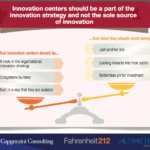How corporate innovation centers make companies competitive
How corporate innovation centers make companies competitive1

One of the most famous advertisements in history, the “Kodak Moment,” symbolized much more than a brand. It was a mantra of life, one that united pictures, memories, and nostalgia.
The new “Kodak Moment” is that moment when executives miss how customers and markets are shifting in favor of preserving legacy mindsets and shareholder value. Kodak is one of the most oft-cited examples for a company that missed its turn at innovation, instead gripping with all its might to a decaying rope of legacy products and process. As digital inevitably gained traction, Kodak’s fate was forever imprinted on the company’s lifeblood…film.
See also: How Helsinki is bringing corporate innovation to their core
Innovation was and is essential to the success of any company. And those that do not disrupt their own businesses will have gift of disruption given to them. But innovation isn’t the only answer. Technology is an enabler of something greater. Visionary leadership, a culture of empowerment and collaboration and a new standard for risk-taking and reward are also keys to compete for the future.
Understanding corporate innovation is a mission that CapGemini’s Jerome Buvat and I (in my work at Altimeter) have focused on for over two years. To date, we have published a series of reports on the subject that surface trends, technologies, challenges and opportunities associated with all forms of innovation models. Our latest study, “
Our latest study, “The Spread of Innovation Around the World,” explores the continued expansion of innovation centers, the ever-shifting focus on emerging technologies, shifting business goals and priorities and the archetypes for innovation approaches.
Defining innovation centers
Innovation is a word that is often overused and misunderstood. Yet, it’s the very thing that is driving the next economy. Startups and global companies alike are increasingly investing in new technologies and technology ecosystems to compete for the future. But innovation isn’t just about new technology and the latest trends, it’s about how leaders see new opportunities and apply inventive solutions to fix what’s broken, improve the status quo and create what doesn’t yet exist.
While startups are making headlines as they shape and reshape the future, big, stodgy companies, once considered too big to innovate, have been playing the startup game in their own way. Now it’s becoming standard practice for enterprise organizations to complement R&D efforts by investing in innovation programs directly in tech capitals around the world.
Innovation centers are on the rise and notably so. In our first report, we documented a total of 301 bona fide corporate innovation centers around the world in July 2015. By February 2016, that number grew to 368. As of October 2016, the number of innovation centers swelled to 456.

So what are innovation centers exactly?
Innovation centers represent enterprise investments in understanding new market dynamics, acquiring new expertise and resources, and also aligning with entrepreneurs, startups, investors, academic institutions, and related ecosystems driving new trends. Innovation centers assume many shapes, but at their core, they are comprised of special teams of intrapreneurs inhouse or moved into dedicated sites within relevant global tech hubs. They function outside of the traditional operational landscape with the goal of accelerating digital innovation, rethinking customer experience, improving operational efficiency and testing new business models.
Over time, the focus of innovation centers shifts to align with technology trends. From March to October 2016, big data and analytics topped the list at 28% with IoT and Cloud following at 26% and 23% respectively. In order of priority, other technologies were also among the top areas of investment including robotics, fintech, biotech/digital healthcare, AI and cybersecurity.
Overcoming the “Kodak Moment”
Experts agree that digital delivered a fatal blow to Kodak. But, the company’s demise was found to be caused by a series of malignant illnesses. Ironically, Kodak pioneered the technology that ushered in a new culture of photography. Yet, Kodak was indeed actively investing in innovation at the time. And, this is a lesson for every company that’s actively establishing innovation centers around the world. Kodak’s fall from grace can be traced to not executing on new fronts. Even though innovation was present, it was not given serious consideration by decision-makers not qualified to was in large part, due to the lack of vision, execution and risk-taking among the C-Suite and shareholders. As a result, innovation was never given a chance to succeed.
There’s a lesson here for all companies when it comes to innovation, technology is only part of the story. The rest is enlivened through social science ranging from anthropology sociology, ethnography, etc.
While Kodak was in the business of preserving memories new players in the space such as Sony, helped shift the world of photography to that of sharing experiences. Consumer shifts were also the result of how technology impacted behavior and as customers evolved, so did their preferences, expectations, and their perspectives around photography, pictures and moments.
Innovation centers are just the beginning. The new Kodak Moment can further signify the moment leaders see how and why people are changing markets and how to deliver new value.
In previous reports, we found that one of the biggest challenges innovation teams face is bridging new opportunities back into headquarters or having deeper impact within the organization. Organizational leadership must double down on a balance between what I refer to as “iteration” and innovation. Simply defined, iteration is doing the same things more efficiently, better or differently. Innovation on the other hand, is doing new things that introduce new value. Therefore, dedicating resources to innovation must be more than a playing with new toys, hanging out with the cool kids or operating on a lean or bootstrap model to feel startup empathy.
Innovation is a way of business and it cannot be left to just one group. Innovation must become part of the culture and how company’s work. Everyone must push forward in their own work, perspectives and creating new value.
To that end, your role in change is to ensure that innovation centers are…
- A node in the organization business and innovation strategy.
- A value-added part of the local technology ecosystem.
- Scalable and effective outside and inside the organization.
At the same time, your work must make sure that innovation centers are not..
- Yet another silo.
- Insular or too inward looking or blinded by technology sectors.
- A bottomless pit for investment.
Innovate…or die!
While we will always see the rise and shifts of innovation centers around the world, innovation itself is not measured by how many innovation centers or technology bets are in play. Innovation is a result or an outcome. It’s measured by the impact of new products, methodologies, mindset shifts, new expertise and ideas executed. But make no mistake, innovation centers are attempts at thwarting disruption. And these strategic moves by companies seeking to outsmart disruption usually become the disruptors when they allow for innovation to become part of the corporate DNA.
Please read the report below or download at Slideshare. You can also Pdownload our previous research on innovation centers from Slideshare.
Part 1: The Innovation Game: Why and How Businesses are Investing in Innovation Centers
Part 2: Digital Dynasties: The Rise of Innovation Empires Worldwide
The post How corporate innovation centers make companies competitive appeared first on ReadWrite.
(22)














